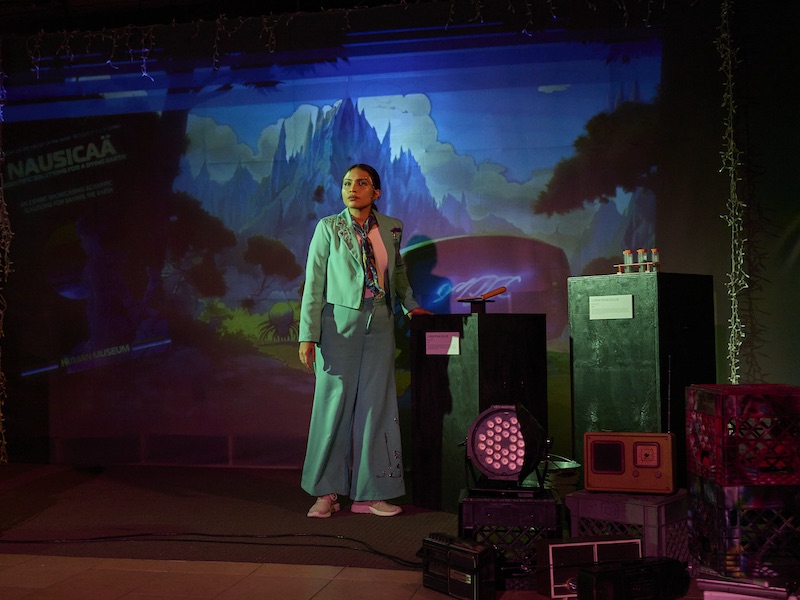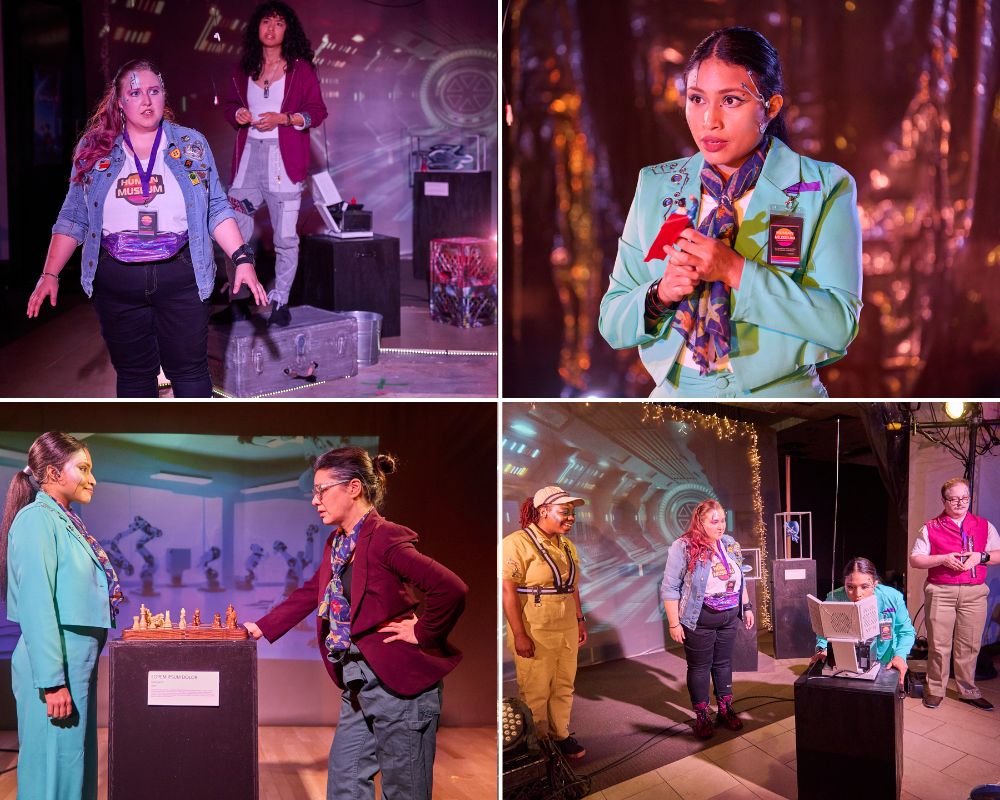No one likes to think about their own death. Certainly no one likes to think about the death of the entire human race. To do so is frightening, depressing, and just plain uncomfortable. Rorschach Theatre’s Human Museum throws comfort to the wind by confronting the demise of the human race head-on, with heart, humor, and Twinkies.
Welcome to the not-so-distant future, in which humans have gone extinct due to a series of natural disasters brought on by their own environmental destruction. Playwright Miyoko Conley’s eccentric story takes place at the titular Human Museum, an institute dedicated to remembering humans. The team of robots who run the museum are preparing to unveil a new exhibit about the final days of the human species, detailing how humans failed to save the planet and themselves.

Human Museum is a uniquely immersive play. The production is housed in a converted retail space, the entirety of which is staged as the setting of the play — the Human Museum. Before the performance, audience members are encouraged to walk around and view the different exhibits on human life. Some of these exhibits feature real “artifacts” of the human world, such as a display of a melted clock (“While humans generally perceived time through memory, they frequently used devices such as this to divide their days and plan their many activities”), while others are imaginings of a future where humans succumbed to a dying planet, such as an arrangement of plants labeled “Eco Experiments, failed” (“These are samples of humans’ many failed attempts to regrow the destroyed environment”). One tongue-in-cheek exhibit recalls the human love of snack foods, especially Twinkies, which come to be a mascot food of the apocalypse in this fictional world.
The production itself plays out in a corridor between two parallel rows of seating, more like the setup for a basketball game than a play. This intimate setting allows audience members to be wholly immersed in the story; however, some of the seats have lower visibility, making viewing every piece of the action slightly difficult.
Screens on either end of the playing area are used to display video. The integration of video, including home movies and museum commercials, adds an entertaining multimedia element to the production. The story is told through artifacts and video as much as it is told through the characters’ words and actions, providing a fascinating theatergoing experience.
In Human Museum, the plot occurs across space, time, and data streams. The play is told through a seamlessly woven tapestry of moments from the present and past. While the robots prepare the latest exhibit of the Human Museum, the museum director, played by Ixchel, finds herself thrown back into memories of the human scientist who created her. A spunky and sweet museum curator named 237, played by Rebecca Husk, relishes in the ability to remember human life, while her coworker 65, played by Aron Spellane, struggles with the burden of holding onto all the knowledge of a dead species. A shocking discovery made by 237 adds another twisted layer to the story, forcing each robot to reexamine their mission.

The performances from the cast are all warm, tender, and, well, human. Rebecca Husk radiates authenticity and warmth as 237, a robot with a heightened sense of sensitivity, while Aron Spellane contrasts her perfectly as 65, a grumpy and sarcastic robot who is more interested in data and logic. Jennifer Knight is wonderfully vivacious as the kind scientist fighting to save her dying species, and Ixchel is powerful as the museum director who holds the legacy of humankind on her shoulders. Ayanna Fowler gives a marvelous performance as a goofy delivery bot, providing comic relief that balances out the somewhat dark story. Bri Houtman’s astonishingly genuine performance as Avery, a human whose story becomes important to the museum team, is the emotional core of this work, with her powerful delivery of monologues that are intense, moving, and unforgettable.
The premise of Human Museum is incredibly original, fascinating, and prescient. At times, the script veers toward sentimentality, but generally, it remains grounded in the gripping reality of an all-too-possible “What if?” scenario. Despite the morbid premise, Human Museum manages to infuse fun and delight into this imagined future, with the heart of the story being a loveable crew of robots who are more human than they think.
Running Time: 95 minutes with no intermission.
Human Museum plays through May 5, 2024 (Thursdays through Sundays), presented by Rorschach Theatre performing at Washington Square, 1020 Connecticut Avenue NW, Washington, DC (near the Farragut North Metro Station). Purchase tickets ($50 Adult; $35 Student and Senior) online. Discounts, including information about limited $20 tickets, can be found here.
The program for Human Museum is online here.
COVID Safety: Masks are optional.
Human Museum
Written by Miyoko Conley
Directed by Randy Baker
FEATURING
237: Rebecca Husk
The Director: Ixchel
65: Aron Spellane
Delivery Bot: Ayanna Fowler
The Scientist: Jennifer Knight
Avery: Bri Houtman
Set Design by Gavin Mosier; Sound Design by Ian Vespermann; Costume Design by Ashlynne Ludwig; Lighting Design by Hailey LaRoe; Video Design by Kylos Brannon; Props Design by Rooster Skylar Sultan; Stage Manager Sophia Menconi; Assistant Stage Manager Natasha Sánchez





The link for the program leads to ad different article, not the program.
Thanks for catching that. It’s fixed.